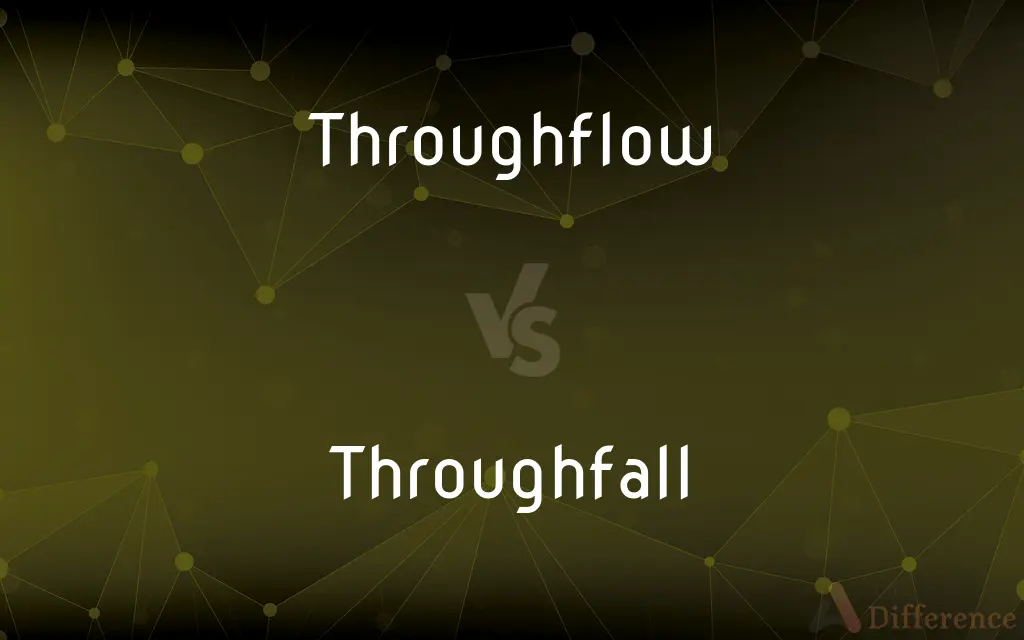Throughflow vs. Throughfall — What's the Difference?
By Fiza Rafique & Maham Liaqat — Updated on May 6, 2024
Throughflow is the horizontal movement of water within the soil layer, while throughfall refers to precipitation that directly falls through gaps in vegetation or drips off leaves.

Difference Between Throughflow and Throughfall
Table of Contents
ADVERTISEMENT
Key Differences
Throughflow occurs as water moves horizontally through the soil, influenced by soil permeability and slope. This process plays a critical role in groundwater recharge and the hydrological cycle. On the other hand, throughfall is the part of precipitation that directly reaches the forest floor, either falling through gaps in the vegetation or dripping off leaves and branches. It contributes significantly to soil moisture and the immediate availability of water for plants.
While throughflow's speed and volume are largely determined by soil characteristics and topography, throughfall's dynamics are influenced by the type, density, and arrangement of vegetation. Throughfall can vary significantly across different types of forests and seasons, affecting local water cycles and ecosystems.
Throughflow typically involves water that has already been partly absorbed by the soil and can carry dissolved nutrients and minerals across different parts of an ecosystem. Conversely, throughfall is more directly influenced by atmospheric conditions and can be affected by pollutants and particulates that water collects as it falls.
Throughflow can be a slower process, depending on the permeability of the soil and the terrain's slope. This slow movement can benefit ecosystems by providing a steady supply of water. Throughfall, however, provides a more immediate and sometimes abundant supply of water, which can lead to rapid changes in soil moisture levels.
Comparison Chart
Definition
Horizontal movement of water within the soil
Precipitation that falls through or off vegetation
ADVERTISEMENT
Primary Influence
Soil permeability, slope
Type, density of vegetation
Role in Hydrological Cycle
Contributes to groundwater recharge
Affects soil moisture directly
Speed
Generally slow, varies with soil and slope
Relatively fast, influenced by rainfall intensity
Environmental Impact
Distributes nutrients, supports aquifers
Can influence local flooding, erosion
Compare with Definitions
Throughflow
Horizontal subsurface water movement.
Throughflow is observed more prominently on sloped terrains after heavy rains.
Throughfall
Direct precipitation interception by vegetation.
Throughfall measurements help in understanding the water budget of forested areas.
Throughflow
Soil-filtered water transport.
The forest's throughflow can alter the chemical composition of downstream waters.
Throughfall
Variability by canopy structure.
Dense canopies can reduce the amount of throughfall reaching the ground.
Throughflow
Part of the subsurface hydrological cycle.
Throughflow contributes significantly to maintaining the base flow of rivers.
Throughfall
Can be affected by atmospheric pollutants.
Throughfall can carry pollutants from the air to the forest floor.
Throughflow
Influenced by soil structure.
Clay soils often result in slower throughflow rates.
Throughfall
Immediate soil impact.
Throughfall quickly alters the moisture content of the soil beneath trees.
Throughflow
Interacts with groundwater.
Throughflow often feeds into groundwater reserves, replenishing them.
Throughfall
Involves water dripping off leaves and branches.
After a storm, the throughfall from trees increases significantly.
Throughflow
In hydrology, throughflow, a subtype of interflow (percolation), is the lateral unsaturated flow of water in the soil zone, typically through a highly permeable geologic unit overlying a less permeable one. Water thus returns to the surface, as return flow, before or on entering a stream or groundwater.
Throughfall
In Hydrology, throughfall is the process which describes how wet leaves shed excess water onto the ground surface. These drops have greater erosive power because they are heavier than rain drops.
Throughflow
(hydrology) The movement of water horizontally beneath the land surface, usually when the soil is completely saturated.
Throughfall
(hydrology) The shedding of excess water from leaves to the ground.
Throughflow
(hydrology) The movement of an identifiably separate body of water through a larger body (such as a current of fresh water through salt water).
Common Curiosities
Can throughfall affect water quality?
Yes, it can introduce atmospheric pollutants to the soil.
Why is throughflow important to ecosystems?
It redistributes water and nutrients horizontally within the soil.
How does seasonal variation affect throughfall?
It is higher during wet seasons due to increased precipitation.
Does throughflow affect all types of soil the same way?
No, it varies with soil type, especially permeability.
What is the ecological significance of throughflow?
It supports diverse habitats by maintaining soil moisture.
Is throughfall always beneficial to forests?
Generally yes, but excessive throughfall can lead to soil erosion.
What determines the rate of throughflow?
Soil permeability and terrain slope are primary factors.
How do forest managers use knowledge of throughfall?
To manage water resources and assess ecosystem health.
How does throughfall differ from stemflow?
Throughfall is direct drip or gap fall, whereas stemflow is water running down plant stems.
What factors can increase throughfall volume?
Heavy rainfall and sparse canopy cover.
Can human activities influence throughflow?
Yes, through land use changes and soil compaction.
How do different vegetation types affect throughfall?
Dense foliage can decrease throughfall due to interception.
Share Your Discovery

Previous Comparison
Frugal vs. Miser
Next Comparison
Coconut vs. CocoAuthor Spotlight
Written by
Fiza RafiqueFiza Rafique is a skilled content writer at AskDifference.com, where she meticulously refines and enhances written pieces. Drawing from her vast editorial expertise, Fiza ensures clarity, accuracy, and precision in every article. Passionate about language, she continually seeks to elevate the quality of content for readers worldwide.
Co-written by
Maham Liaqat












































